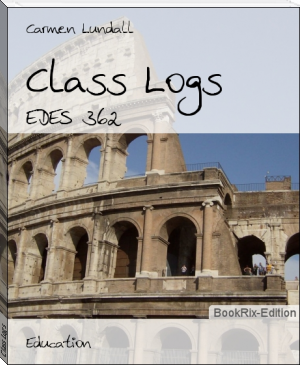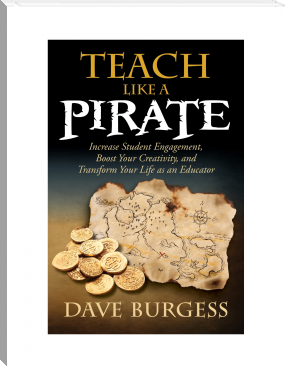Class Logs, Carmen Lundall [e book reader android .TXT] 📗

- Author: Carmen Lundall
Book online «Class Logs, Carmen Lundall [e book reader android .TXT] 📗». Author Carmen Lundall
I think today’s class was very beneficial in understanding the purpose of writing and the strategies presented will aid in the writing process for students, and for teaching writing to my students. One strategy I connected with is R.A.F.T.S. I think this approach helps students generate ideas and focuses their writing. We used the example of a lost shoe and it was interesting to hear the creativity that my peers can come up with and I can only imagine what middle school students would do. I like what it says on the worksheet “Designing Writing Assignments with R.A.F.T.S.” It says, “Designing writing assignments using R.A.F.T.S. can help a teacher to identify and incorporate the elements of effective writing. Effective writing assignments enable students to write fluently and purposefully for and audience.” I think this sums up the purpose of R.A.F.T.S. and the reason I would use this strategy in my classroom. Students need to have a purpose for writing and this is a great way to teach them this concept and narrow down the purpose of writing.
Tuesday October 13, 2009
For this article, I would have a giant heart – to represent the personal connection I have when reading this article. I struggled with reading and comprehension throughout middle school and high school. I found it hard to concentrate and read to understand. I would read everything I was assigned by the due date, but would have a lot of trouble making inferences from my readings and often have to read through the material a couple of times. A part from my parents, no one showed me how to comprehend what I was reading or provide me with reading strategies. Teaching students the different reading strategies they can use and showing them how they can improve their reading is important and many students struggle with it. Personally, I have to summarize what I’ve read after I am done to make sure that I understand, I also find it helpful to discuss the material with a partner. This does take up a lot of time, but is essential for me in my comprehension of material. I also think many students may be embarrassed to admit when they don’t understand what they’re reading. Using the strategies suggested here as a whole class activity may help students realize that they are not the only students struggling in this area. I also think that when we teach students different teaching strategies, they are learning the importance of reading to understand, and to take the time to make notes about their readings. When an idea such as the one in the article is done with the whole class, students see the importance of the skill, and it becomes engaging for the students. They don’t realize that they are looking for comprehension as they are putting the symbols on the paper, they might even like doing it! I also think this strategy provides a visual aid for students to see the areas in which they do relate to subject matter, as well as shows them how much or how little they understand while they are reading.
When I first started reading the second article, I was confused. I am not sure if it was the style of writing or that I didn’t understand the words I was reading. I contemplated not reading the rest and coming back to it later, but decided to continue forward. In doing this I realized the value and extreme importance of teaching essay writing from the very beginning, and providing visuals and practical examples (suits, different colour markers on the board). I had a very good high school English teacher who taught us very well how to create topic sentences and thesis statements, but we got lost in the essay writing skill. I think the emphasis on essays as I was in elementary and junior high school was simply the structure – Introduction, three paragraphs, conclusions = five paragraphs in total, that’s it! Unfortunately I never understood what an essay was and how to write one. I appreciate the enthusiasm expressed by the author and how he highlights the importance of teaching students what an essay is – defining it, picturing its shape, understanding the type of writing to use, etc. Before students can jump right into an essay, we need to teach the very basics – something I had thought of, but didn’t think about until reading this article.
Tuesday October 20, 2009
There were many mini-lessons today that I thought were very good, and stood out to me. I related to the content of Tia’s lesson because I remember reading Dr. Seuss as a child and enjoying the stories. Before Tia’s presentation, I hadn’t thought about the implications and “big ideas” involved in his stories, nor did I realize how these themes can impact my student’s lives. In hearing the different ways that Dr. Seuss can be used in the classroom, I became very excited and look forward to using this technique in my classroom. I would definitely use Dr. Seuss books in the classroom for elementary school, or as an analysis or example for middle school for students to find the “big idea”. Having worked mostly with grade eight and nine in my IPT and extended practicum, I worry about how enthusiastic or relevant this topic would be for this age group. I think that these students would understand how to find the themes presented, but I think they would joke around and not take it seriously (the majority of students). I think that this approach would be a great tool for a piece of a thematic unit; however I would have to see it used first hand in the classroom as an entire thematic unit. In the case of elementary school, I believe that using this approach as an entire thematic unit would be very beneficial to the students because they would relate to the subject matter and would be more relevant to their lives. There would be a lot of learning concepts involved that would be new to the students – social considerations that impact them for ate rest of their lives.
Poetry is a great form of literature and is often overlooked by students because they think it is boring or do not understand what it means. Poetry is a beautiful way of expressing yourself. I thought that Trisha’s mini-lesson was very informative and I appreciated her comment about using poetry as a way to vent. I think if you told students this they would understand better reasons for poetry and maybe find it easier to write and see the implications it has on literature and self-expression. Students need to be presented with opportunities to present their feelings and rather than always writing a short paragraph or story, we should encourage students to use poetry also as a means of expressing themselves and see the many different ways it can be used and has been used in the past.
In explaining the different ways poetry can be used in the classroom, Trisha gave us an activity called “Mad Libs”. For this activity, students are given a poem with words missing, and their job, with a partner, is to fill in the blanks with a noun, verb, or adjective, as indicated on the poem provided. Each partner fills the poem out for their partner – they ask their partner for a noun, verb, or adjective and fill the word in as indicated on their poem. The students continue until the poem is finished and they then read their poems out loud to each other. This activity is fun and a creative and interactive way to introduce poetry to your students.
The article “Action Strategies for deepening Comprehension” was very good, relevant, and easy to relate to. The main focus is engaging ALL – good, reluctant, and struggling – readers through the use of “enactment strategies” to motivate students. The opening vignettes provided a number of examples that teacher’s have used in their classrooms. When reading about the strategies it is hard to understand just how much impact these strategies can have on student learning. Throughout EDES 362, many of the strategies listed have been modelled for us, which provides me with confidence that these strategies DO work. As strategies are modelled and we participate as students it is clear to see how motivating and incredibly necessary these strategies are in creating successful reading experiences. As a university student, I need to be actively engage and involved in my learning so that I am increasingly motivated to continue learning; I believe it is the same for middle school students. I think part of motivating your students is contributed to how you teach and treat your learners. Along with Adults, students need to feel safe and trusted within their classroom and must receive a variety of opportunities to feel success in their learning
Tuesday October 27, 2009
This article is helpful as we begin searching for themes for our unit plan. Sometimes it becomes overwhelming when you are developing your theme because you can fire off 100 different activities that students can do but forget the purpose of the theme and the learning that can and needs to take place during the thematic unit. A part the Fogarty makes that clearly illustrates this is “Be clear on your criteria for selecting the theme!” I think one of the most important facets of thematic units is the essential questions. These provide the excitement and encourage deep-level thinking for the students, because the questions can’t be answered without exploring their learning first. I think integrating themes across all the subjects is a great way to increase student learning, but I wonder if the students get bored or tired of using the same theme for a number of classes for an x amount of weeks. How can you ensure that your students are actively engaged throughout the course of the unit?
In the second article, using this approach to increase reading comprehension, in my opinion, seems that it





Comments (0)